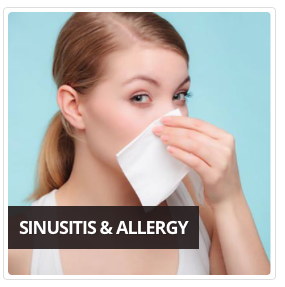Itchy eyes, a congested nose, sneezing, wheezing and hives: these are all of the symptoms of seasonal allergies. Many people use hay fever as a colloquial term for these seasonal allergies and the inflammation of the nose and airways.
Fall — It’s a beautiful time where the leaves are changing, the summer heat is finally start to cool off, and pumpkin spice lattes can solve pretty much anything… except for allergies, that is.
With a climate change, comes a higher risk of individuals suffering from seasonal allergies, and due to Fall’s dry and cool air, cases of sinusitis especially increase during this time.
Although allergy symptoms become more common during the Autumn months, that doesn’t mean they should be ignored. In fact, what you should know about sinusitis is that it actually comes in two forms.
Acute sinusitis is a more mild form of a sinus infection that may be brought on by a common cold or allergies. In most cases, it does not last longer than a few days and can clean up on its own. However, there are some instances where a pain reliever and a decongestant is recommended. A more serious case of a sinus infection is considered chronic sinusitis. This form can be caused, too, by a cold or allergies, but more so, an infection, such as an untreated sinus infection or some sort of abnormal growth.
In any case of sinusitis, the cavities that surround the nasal passages become inflamed due to the bacteria that may be present in the mucus that is causing you congestion. This can cause the feeling of tension oftentimes accompanied by ache or discomfort in the middle portion of the face (sides of the nose and underneath the eyes). Other symptoms commonly associated with a sinus infection could be fever, tenderness around the nose, post-nasal drip, discolored mucous discharge (greenish-yellow), bad breath and a headache or pressure when you lean forward or lay down.
Luckily, an acute sinus infection typically only lasts between 2-7 days. However, there are instances where the symptoms may persist or worsen, in which case you may need to be prescribed antibiotics for treatment.
For more frequent, serious cases of sinus infections, some people may even consider a procedure known as Balloon Sinuplasty. This incision-free surgery will help alleviate the issues that bring on the sinus infection as it works to correct sinus blockage.
Effects of Seasonal Allergies
| Symptoms | Cold | Airborne Allergy |
|---|---|---|
| Cough | Common | Sometimes |
| General Aches, Pains | Slight | Never |
| Fatigue, Weakness | Sometimes | Sometimes |
| Itchy Eyes | Rare or Never | Common |
| Sneezing | Usual | Usual |
| Sore Throat | Common | Sometimes |
| Runny Nose | Common | Common |
| Stuffy Nose | Common | Common |
| Fever | Rare | Never |
| Duration | 3 to 14 days | Weeks (for example, 6 weeks for ragweed or grass pollen seasons) |
| Treatment |
|
|
| Prevention |
|
|
| Complications |
|
|
We have four paired paranasal sinuses:
Maxillary sinuses are behind the cheekbone and facial pain in this area may also radiate to the teeth or ears.
Frontal sinuses are in the forehead region.
Ethmoid sinuses are between the eyes. Facial pain or pressure in these sinuses may radiate to the forehead or eyes.
Sphenoid sinuses are in the center of the skull and may cause pain radiating to the top and back of the head. Because the sinuses drain into the back of the nasal cavity, symptoms may include nasal stuffiness and congestion. When the condition is severe, the eyes may fail to drain into the nose resulting in watery eyes. If the middle ears fail to drain into the nose, ear pressure, pain or dizziness may occur.
The main goal of this Balloon Sinuplasty is to help restore normal sinus drainage back to the nasal system and improve mucous circulation. Unlike a typical sinus surgery, this procedure is performed by going through the nostrils with a small balloon catheter to help open up the obstructed nasal passages. This option is best for individuals that are hesitant about going in for an invasive surgical procedure since there is very little bleeding, only minor discomfort, no incisions, and patients may return to regular day-to-day activities within 24 hours.
Dr. Monica Tadros specializes in treating season allergies for her patients in NYC & NJ. Schedule your your no-obligation consultation today to learn more about treating your seasonal allergies.



